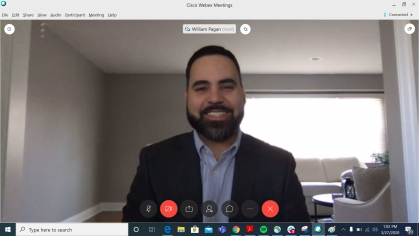How to Succeed in the Rush Toward Online Learning

At emergency speed, COVID-19 is forcing educators worldwide to jump into the deep end of online learning.
The Division of Continuing Studies (DoCS) at Rutgers, created in 1996 to leverage the power of online instruction, is advising the hundreds of instructors rushing online to focus on student needs before even thinking about the technology.
Will Pagan, director of instructional design for Rutgers Teaching and Learning with Technology (TLT) at DoCS, took time during a recent busy day to explain best practices of online learning, based on the division’s 25-year experience.
This has truly been a crisis situation, and everyone is moving fast to keep classes going. But people have a wide variety of online skills. What’s the process been for you, working with faculty?
We try to meet the teachers where they are. Yes, we’re in a crisis, but this is still about good teaching. You want to be thoughtful as you plan your lessons. How can you most clearly communicate what you need? How can your students best take in this information? How can they communicate mastery of material? How can they learn from and with each other? It might be through their answers in threaded discussions, or by explaining a topic in their own words in short videos or in their online critiques of a paper or video you share. We help instructors ask and answer those questions before even discussing technology.
How do you advise instructors who say: “I’ve taught this course for a long time; I just need to find a way to deliver my regular lectures online.”
In this moment of crisis, if that’s what the teacher is most comfortable with, we’ll work with them to use that as a starting point. And we’ll encourage them to build from there. We’ll help identify opportunities to break material into chunks. Can portions be delivered asynchronously? That means students can access the material anytime their home or work schedule allows it. By breaking a 60-minute lecture into 10 six-minute chunks, students can experience it at their own time and pace. Asynchronous learning also helps answer some of the logistical problems people are facing right now. Teachers may suddenly have small children at home they have to care for. Students may have been given extra shifts at work.
Right, with asynchronous learning, it’s at their pace and at their own convenience. When students have a moment to get to the content, they can. If that free time only comes at two in the morning, they can go on and still be engaged with the course and with their classmates.
What sort of things won’t work in this situation? What are the potential problems teachers might not have had to consider before?
There are some little logistical things. For example, if you have a large number of students, you don’t necessarily want all of them to have their webcams on at the same time. That can pose some unnecessary strain on the system. You definitely want them to mute their microphones, unless they’re asking a question. You know, there’s an assumption in a lecture hall that people will be quiet, but here, when you have a microphone on, you get all the background noise – even students typing notes can be a distraction.
In a regular classroom, even with the teacher present, there’s such a temptation for students to slip into passive learning – sitting there, maybe taking notes, but not really engaging, moment to moment. How do you combat that in an online class?
There are a lot of interactive tools. One easy one, right at your disposal, is to do a poll. It’s an easy way to not only pose a question, but really take the pulse of the class. You put out a multiple-choice question, or a problem, and you instantly see – oh, 80 percent just got that wrong, I’d better go over that concept again. It’s immediate feedback.
At Rutgers, instructors also have no-cost access to Kaltura, for example, which is sort of a YouTube for higher education. You can record yourself, store your videos there. It’s a great tool for instructors and for students, who can record themselves doing a presentation, and then upload it for the class to see. It’s relatively simple.
Crises like these can also provide an opportunity to challenge our assumptions. Going forward, once everyone’s back on campus, do you see people incorporating some of these methods into their regular teaching?
I think, at the very least, people are going to be more open to online instruction after this. Having done it, they’ll think “Hey, this isn’t so scary, this wasn’t as daunting as I thought.” My own personal experience, talking to faculty, I always leave the technology part of the conversation for the very last. My main focus is the content – the teaching is first and foremost. And then, once we’ve discussed that, we figure the last part out together: How can we best do this in the online space? What tools work best for you, and the student? And then I say, OK, after the semester, come back to me, tell me: How did it work? If it didn’t, well, fine, let’s scrap that approach and find another way. And if it worked well, great. Now – here are some new tools to try out.
In the longer run, what are you seeing through the chaos and confusion of the day?
Without overstating the case, we’re seeing that the response to COVID-19 may be transformational not just for Rutgers but for higher ed across the country. Online education is carving out a space that many couldn’t see before – as the main delivery vehicle for education and as the only viable and reliable means of ensuring continuity of instruction during emergencies. School closings during bad weather will soon be a thing of the past. Global programming and collaborations will get a major boost. From the other side of this crisis, COVID-19 response may be remembered as a major milestone in these positive developments.


